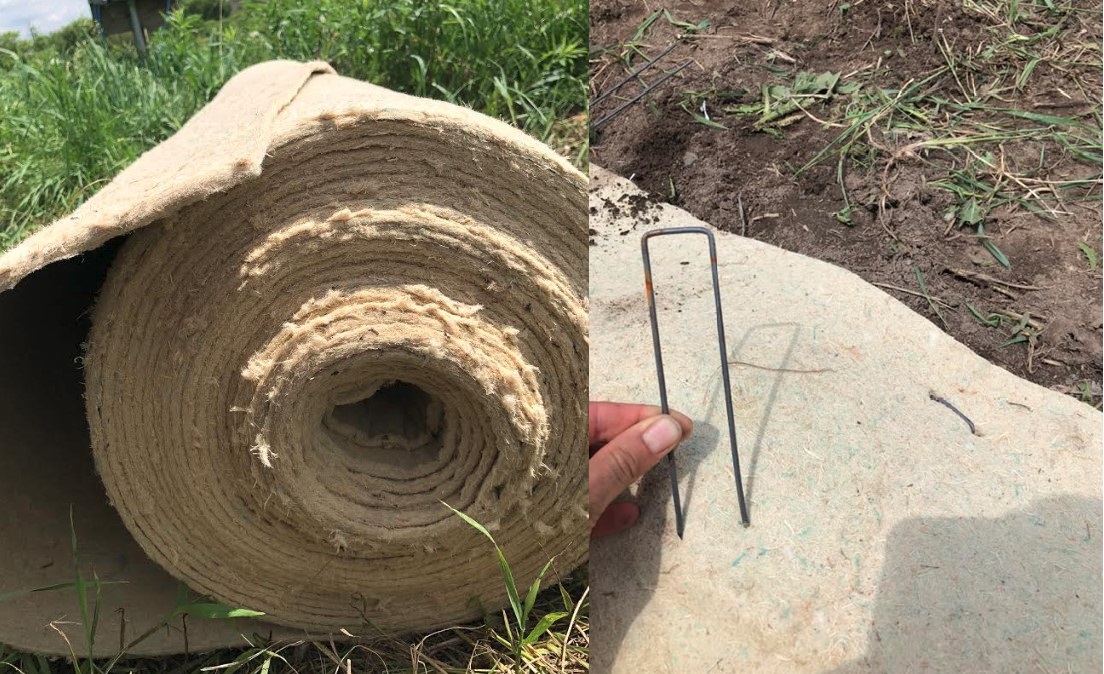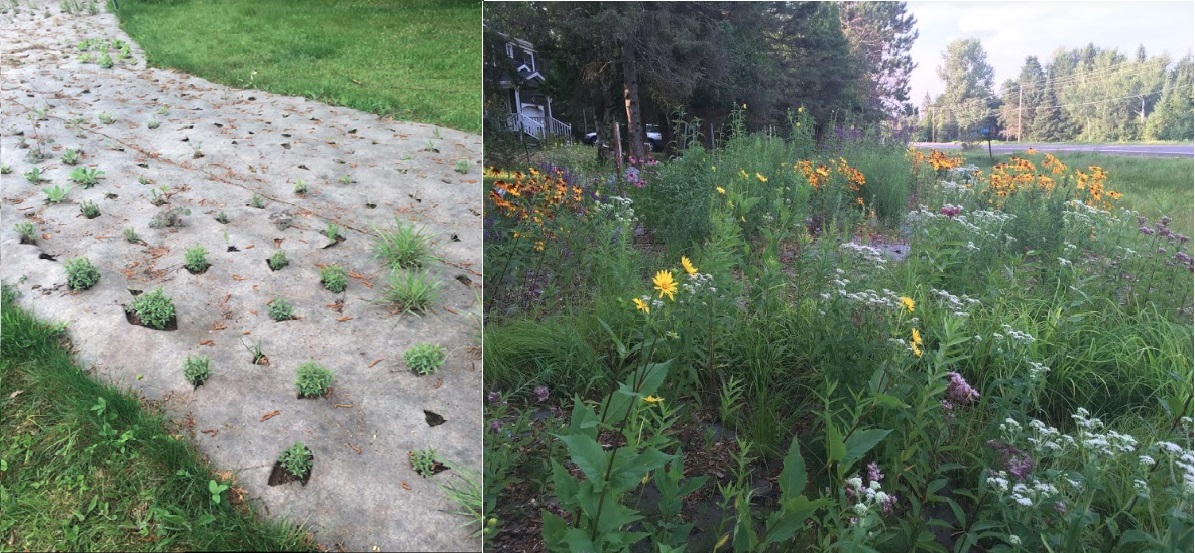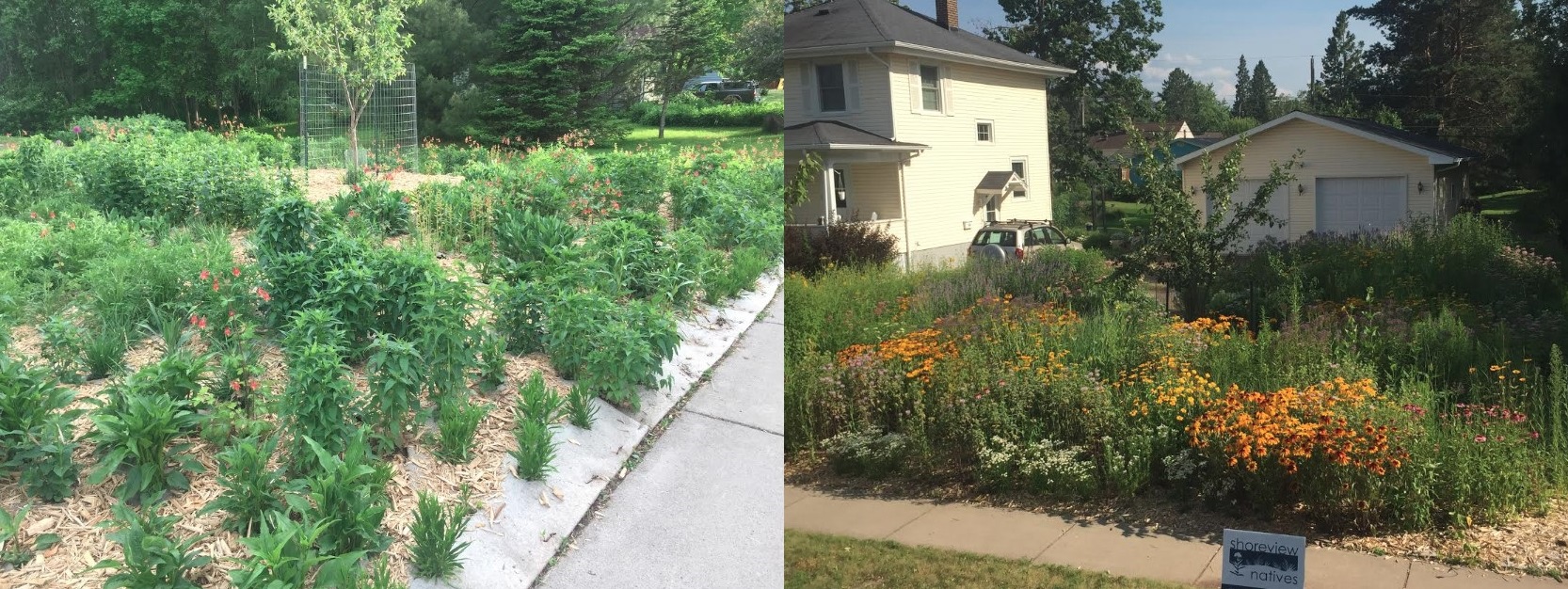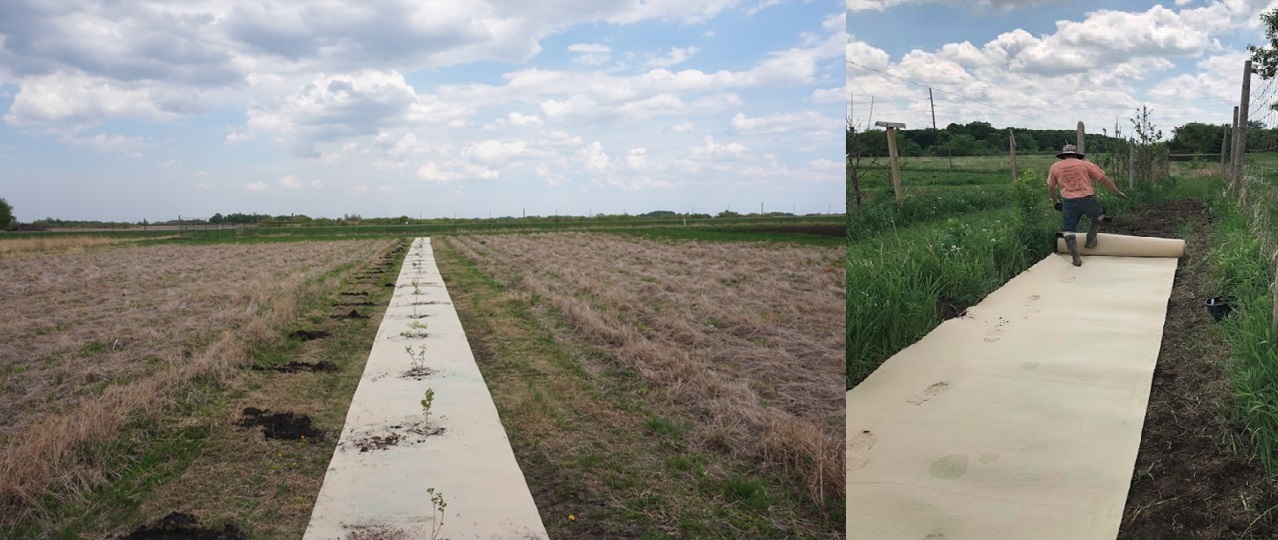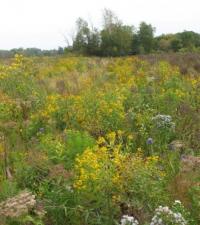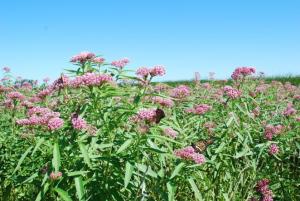What's Working for Conservation
Pollinator Habitat
2025 Information
Turf Conversion Projects:
The following are turf conversion recommendations and lessons learned from RES (Resource Environmental Solutions LLC).
- Ensure your seed mix matches the soil texture and moisture regime of the site.
- Tilling is generally not recommended unless soils are severely compacted as it is disruptive and can be problematic – especially on slopes, near waterbodies, or on sites over ~0.5 acre where tilling would leave soil exposed for more than 7 days, creating a potential erosion concern.
- When feasible, we prefer to spray turf/weeds with herbicide (multiple times) and then drill seed directly into the dead thatch. Drilling is important for ensuring good germination of the cover crop; native seed can be broadcast and raked into the thatch, but this practice does not result in good germination of cover crop.
- Smaller turf sites, lacking steep slopes, and not near water bodies may best be converted to natives by spraying with herbicide (multiple times), tilling, and seeding. Tilling should be followed by at least one herbicide treatment. The tilling helps to flush weed seeds, but also helps to ensure the larger cover crop grain is planted deep enough into the soil for sites that cannot be drilled. This approach results in the area being left exposed for a longer period of time; hence why it is most applicable to small sites and/or sites not prone to erosion. Straw mulch is typically spread and crimped into the soil following seeding to control erosion. Because of the additional steps, this approach tends to be more expensive and takes longer than killing turf in place and drilling into the thatch.
- Hydroseeding of natives is not recommended, as it often results in poor seed-to-soil contact and poor germination. Native seed can be drilled or sown and covered with a thin layer of hydromulch for stabilization purposes (Doug Mensing RES).
Turf Conversion Methods and Lessons from Anoka CD
The following information summarizes lessons from turf conversion projects in Anoka County followed by images of project sites.
Sheet Mulch with Cardboard: If a turf area is small, site prep can be completed by placing a layer of cardboard and one to two inches of mulch to smother unwanted turf and weeds. We allowed the cardboard and mulch to smother weeds for one growing season. When we planted in the fall, the turf was not alive under the cardboard and the cardboard was soft and broken down enough, that it was easy to push aside the mulch, punch through the cardboard with a garden trowel, and plant a plant plug.
Site preparation on larger sites: Most larger sites are broadcast sprayed with glyphosate, tilled, and sometimes harrowed to smooth out the soil. Spot herbicide treatments are often needed for weeds. Glyphosate is often used but different herbicides may be used depending on the weeds, such as Transline for Canada thistle.
Seeding and planting: Select species that match the soil, hydrology and sun conditions. The soil conditions influence the plug planting, especially for a volunteer event. Some soils were very compact and it was difficult and slow to use a garden trowel for digging holes. A drill to make holes is more effective. Other soils were easier to dig into and planting was done quickly.
Establishment: Mow the first year after seeding to prevent weeds from producing seeds. Spot herbicide treat as needed. Note that crab grass (annual) grows flat near the ground, making it difficult to mow and prevent seed maturity. We did additional seeding and planting in areas that didn’t establish well with the first seeding and/or plug planting.
Watering: Falls can be dry and warm. We had one planting event in early September 2024 and it was a warm and dry fall. We spent lots of time watering throughout the fall.
Follow- Management: All sites required follow up maintenance and overseeding and/or interplanting to fill in
Partnering: Partnering with City or County staff that have access to equipment and the ability to assist can reduce the cost of projects.
gaps.
Turf Conversion Projects in Anoka County
Site Name: Laddie Lake Park Site Prep Activities: Herbicide in fall 2022 & Tilling in spring 2023 (City of Blaine) Seeding and/or Plug Planting: Seeded onto bare sandy soil in the spring 2023, planted plugs in the fall Follow Up Year 1: Weed whipped weeds, hand pulled weeds, targeted herbicide treatment in spring to fall 2024 Additional Seeding and/or Plug Planting: Additional plugs planted and overseeded Fall 2024 Before. After tilling, before seeding – spring 2023. Volunteer planting – Fall 2023. Volunteer planting - Fall 2024.
|
Site Name: Fridley Commons Park Site Prep Activities: Herbicide spray in fall 2022, tilled and second herbicide treatment in spring 2023 (City of Fridley) Seeding and/or Plug Planting: Seeded onto bare soil in spring 2023, plugs planted fall 2023 Follow Up: Hand weeding, weed whipping, spot treatment of crab grass and thistle in 2024 Additional Seeding and/or Plug Planting: Additional plugs planted and overseeding fall 2024 Before. Seeding – spring 2023. Volunteer planting – fall 2023. July 2024.
|
Site Name: Ehlen Park, Anoka Site Prep Activities: Three Herbicide treatments (two in June and 1 in July), tilling, mulched Seeding and/or Plug Planting: Plug planting Sept 14, 2024 (during a warm dry fall) Follow Up: Weekly Watering Additional Seeding and/or Plug Planting: none
|
Site Name: Bunker Hills Park Gatehouses Site Prep Activities: Herbicide spray the scalp mow in fall 2022. Tilling, targeted herbicide, till for bare soil in spring 2023 Seeding and/or Plug Planting: Seeded and plugs planted 2023 Follow Up: Mowing, hand weeding, spot herbicide spray in spring, summer and fall 2024 Additional Seeding and/or Plug Planting: hand weeding and planted plugs and overseeding fall 2024
|
Site Name: Coon Lake Boat Launch Parking Lot Islands Site Prep Activities: Herbicide spray then scalp mow in fall 2022 Seeding and/or Plug Planting: Seeding in November 2022 Follow Up: Hand weeding in spring and summer 2024 Additional Seeding and/or Plug Planting: Hand weeding and plug planting in fall 2023. Additional plugs and seed planted fall 2024
|
Site Name: Coon Lake Beach Parking Lot Islands Site Prep Activities: Herbicide spray the scalp mow in fall 2022 Seeding and/or Plug Planting: Seeding in December 2022. Spring 2023 planted 34 low bush honeysuckle in one island and 15 sand cherry in another island Follow Up: Tilled all islands expect low bush honeysuckle in spring 2023. Hand weeding in 2024. Planted additional plugs in fall 2024 and overseeding in December 2024 Additional Seeding and/or Plug Planting: Hand weeding and plug planting in fall 2023. Additional plugs and seed planted fall 2024
|
Site Name: Acorn Park Site Prep Activities: Herbicide treatment, Till, Herbicide Treatment in 2022 Seeding and/or Plug Planting: Plug planting in October 2022 and Seeding Late Fall 2022 Follow Up: Hand weeding Additional Seeding and/or Plug Planting: Plugs planted 2024, additional seed Condition in Fall 2024: Sparse vegetation. Few weeds. Very dry sandy soils Planting - 10.10.2022
|
Site Name: Peppermint Stick Park Site Prep Activities: Herbicide treatment, Till, Herbicide Treatment in 2022 Seeding and/or Plug Planting: Plug planting in October 2022 and Seeding Late Fall 2022 Follow Up: hand weed and mow, herbicide spot spray for quack grass Additional Seeding and/or Plug Planting: Additional plugs planted 2024, additional seed late fall 2024 Peppermint Stick Park Before – 5.31.2022. Planting in Fall 2022.
|
Site Name: Rivers Bend Park, Ramsey – multiple small pollinator plantings totaling 0.85 acres Site Prep Activities: Herbicide treatment, Tilled, Harrowed in August 2023 Seeding and/or Plug Planting: Seeded on bare soil (no weeds emerged) in October 2023. Plug planting in September 2024 Follow Up: Small amount of herbicide on monocultures of weeds, and hand weeding in 2024. Additional Seeding and/or Plug Planting: Additional seeding with straw June 2024 (little germination) and overseeding in bare soil areas in November 2024 Site prep. Seeding - Oct 2023. Overseeding and straw mulch due to high % of bare soil – June 2024. Planting Sept 2024.
|
Site Name: ACD office Site Prep Activities: Herbicide treatment – spring 2024. A dense flush of crab grass emerged. Decided to sheet mulch with 1-2 layers of cardboard and layer of mulch in summer 2024 Seeding and/or Plug Planting: Plug planting in Fall 2024. Weeds were dead and the cardboard was easy to cut into after a few months of sheet mulch. (Some weeds were present along the edges.) Planting – Fall 2024 |
2020 Information
Prairie Reconstructions for Pollinators
Prairie Reconstruction for Pollinators (PDF)
Which flowers do bees prefer? Bees use different plants at different times. ( Ian Lane, U of MN Bee Lab )
2019 Information
Permeable Weed Suppression Barrier:
A good weed suppression strategy for new pollinator habitat avoids the use of herbicides. Permeable barriers of biodegradable material can be an excellent way to prepare a new pollinator habitat site. Unlike mostly-synthetic landscaping fabrics, these materials break down over time allowing water and nutrients to infiltrate the soil.
There are a few options for creating this type of permeable weed barrier. Sheet mulching with cardboard, described here by the non-profit group Rennaisance Soil, is an effective option for smaller plantings, but larger installations might require more cardboard than is practical to attain. Commercially available weed suppression material has been used effectively in large scale habitat projects.
Some options are:
WeedGuard Plus Biodegradable Paper Weed Barrier, and Dewitt Paper Mulch. These options are recycled paper products and are manufactured out of state. These papers are designed to last one growing season and organic certified options are available. Rolls of these materials come in a range of widths and lengths, but generally one color, brown.
Weed Suppressant Mat, manufactured by Mat Inc. in Floodwood MN. (shown below) It comes in "natural" and green tint, it’s made of aspen/poplar (roughly 70%), corn (roughly 30%), and a synthetic binder (roughly 5%). It is not organic certified and cannot be used on organic certified crop land (due to the synthetic binder), but it can be used on adjacent habitat areas (at least 10 feet from organic certified land). Rolls are 50 ft by 5 ft, about 1/4 inch thick. Very durable, lasts about 4 years according to the sales rep. Heavy enough that it doesn’t rip easily.
Weed suppression papers or mats are used for installations with container plants (e.g., hedgerows in weedy areas, or landscaping projects with plugs). The mat is laid at planting time, and small holes are cut into it for the plants (native shrubs, forbs, or grasses). By the time the weed suppression material has degraded, the new plants are established enough to outcompete most weeds.
Installation Tips: All edges should be tacked down with 6 inch landscaping staples at a spacing of 18-24 inches, and seams should have 2 inches of overlapping fabric. Rocks or bricks may also be useful, especially on windy sites. If planting shrubs that require deep holes, dig the holes in advance of laying the mat. When cutting the mat for the plants, use a box cutter knife and cut Xs as small as possible, to minimize weedy growth
Dan Schutte: We’ve been having great success using Weed Suppressant Mat for forb plantings. The photos below show the same site shortly after installation, and 1 year later.
The following photos show another site, about 9 months after planting (left) and one year after planting, at the end of the second growing season (right):
Sarah Foltz Jordan: Photos below show examples of native hedgerow plantings in MN using Weed Suppressant Mat. We are interested in seeing how this performs in pretty wet (reed canary) areas using tightly spaced native shrubs. The sales rep says they expect it will hold up fine for a few years on very moist sites. My hope is that it will provide the weed control needed to get the shrubs established, before it breaks down. If it does hold up long enough, this could be a good alternative to plastic mulch, which either has to be removed or eventually ends up fragmented in the soil. (Sarah Foltz Jordan (Xerces Society) and Dan Schutte (Shoreview Natives).
Seeding Rates for Pollinator Plots: I have seen pollinator plots that are all over the board related to forb density. There are a couple that I have seen develop that are 100% forbs. The flower composition is wonderful, there is no competition with the aggressive natives (big blue, Indian, switch) and the understory is amazing brood rearing cover. The downside is that a very heavy forb component makes burning more difficult because there is just not the continuity of fuel. However, if chopping is the preferred method of management, then fuel is not a concern. Something that sticks out with high forb plots is that the ability of the site to shade the ground and ‘smother’ early successional weeds is slower. I believe this is really just cosmetic for most sites. Most weeds we deal with are annuals and don’t pose a problem for establishment. It’s the perception of ‘weeds’ that is usually more of a problem than the actual weeds. Some sites are more prone to perennial weeds (e.g., Canada thistle). In those sites, a more dedicated clipping regime is required, but people have to be willing to give it the necessary effort. Once the forbs are well-established and the broad leaves of the plants shade the soil, then weeds pressure is typically minimal. Forb to grass ratio is also dependent on the aggressiveness of the forbs to be planted. If more aggressive forbs like bergamot or cup plant will be used a lower forb ratio may be appropriate but if less aggressive forbs (blue-eyed grass, prairie phlox, etc. will be used then a high forb ratio would be preferred.
2016 Information
Herbicide Free Methods: Solarizing the existing vegetation with clear UV stabilized plastic is very effective on small patches of land. The plastic usually needs to be left in place for several months during the hottest time of the year before all the vegetation underneath is dead. The goal of solarization is to raise the temperature of the soil high enough to kill any weed seed present. Follow these steps for solarizing:
- Remove all vegetation by mowing and clearing the site in the spring, raking off debris, if necessary.
- After smoothing the site, irrigate thoroughly and lay down UV stabilized plastic (such as high tunnel greenhouse plastic).
- Bury the edges to prevent airflow between the plastic and the ground. Any airflow between the plastic and the ground will lower soil temperatures, allowing more weed seed to survive. Weigh down the center of the plastic if necessary to prevent the wind from lifting it. Use greenhouse repair tape for any rips that occur during the season.
- Remove the plastic in early fall before the weather cools and the area beneath the plastic is recolonized by nearby rhizomatous weeds.
- Immediately plant your seed mix.
(Establishing Pollinator Meadows from Seed. 2013 Publication, Xerces Society)
Site Preparation: The Fond du Lac Band of Lake Superior Chippewa’s Resource Management division conducted a mini-experiment in the summer of 2015 trying three different site-prep methods to establish a small pollinator garden in front of their office building. The Fond du Lac Forester, Wildlife Biologist, and Environmental Educator, teamed up for this project. The goal was to kill the existing vegetation, mostly common weeds and grasses, over the course of the summer to prepare a seedbed to direct-seed a mixture of different pollinator plants in the fall and supplement with potted pollinator plants the following spring.
In mid-May 2015 a 2,000 square foot patch of ground was divided up into three equal areas. Area 1 was treated with the herbicide glyphosate (Round Up, 3% final strength), area 2 was covered in clear plastic that was weighed down and sealed with rocks (a process called “solarization”), and area 3 was treated with household (not horticultural strength) vinegar and dish soap. A back pack sprayer was used to apply the glyphosate and the vinegar. Clear plastic was intentionally used as anecdotal evidence obtained from others suggested it actually works better in Northern Minnesota than black plastic does.
The glyphosate treatment proved the easiest and most effective, requiring 1 full treatment in early summer and a few small spot treatments thereafter to kill newly established plants.
The clear plastic area, despite a very warm summer, mostly failed to kill the plants underneath although was more effective than the vinegar treatment in some places. It simply never got hot enough to kill the majority of plants and enough moisture moved laterally from the outside perimeter to underneath the plastic that many plants didn’t die from drought, either. Holes were torn in the plastic after some very windy storms moved through the area over the summer and had to be repaired. The plastic was tough to clean up at the end of the summer as well, as it really broke down from the UV rays of the sun. At summer’s end, the plastic treatment area received a final glyphosate application to kill the remaining living vegetation.
The vinegar treatment was effective within hours at top killing most, but not all plants. Perennial plants and grasses, such as common tansy and quackgrass were largely unaffected and quickly re-sprouted from the roots. Many gallons of vinegar were applied several times throughout the summer and early fall. As a side-note, the vinegar mixture kills many insects on contact. We sprayed two dozen forest tent caterpillars crawling along the stem of a choke cherry and killed them immediately. The effect would probably be the same with desired insects such as monarch caterpillars.
It wasn’t thought that stronger vinegar (11% horticultural grade vs. 4% household strength) would have made a large difference as it still would have only top killed many plants.
In late-fall 2015 the entire area was very shallowly tilled (1-2” deep) to prepare a seedbed but not bring up deeply buried ungerminated weed seeds that may still be present. The area was hand seeded with pollinator plant seeds mixed with sand for easy dispersal. In May 2016 potted plants were planted to supplement what was seeded the previous fall.
As of July 2016, the area treated with glyphosate and the plastic-area that received a final glyphosate treatment have the least amount of non-desired plants. The vinegar treatment is still plagued by unwanted grass species that are inhibiting the successful establishment of the desired pollinator plants.
Fond du Lac Resource Management doesn’t advocate the use of herbicides for all situations, but they may be the most efficient treatment in certain situations. Non-herbicide site-prep methods exist that weren’t tried in this experiment such as smothering with cardboard, planting cover/smother crops, repeated tilling, and more. (Christian Nelson, FDL Reservation) (Photo credit to Mike Schrage, Fond du Lac Wildlife Biologist)
Seeding Methods: Regardless of the broadcasting method used, you will have the best seeding success by mixing the seed with an equal or greater volume of slightly damp inert materials such as coarse-textured sand, vermiculite, rice hulls, or sawdust. The inert material helps provide proper species distribution within the seed mix, and gives a visual representation of how evenly the seed mix is being spread across the planting area. When broadcast seeding, divide the mixture into two equal quantities, applying half of it to the planting area in one direction. Then, spread the second half of the mixture onto the planting area in a direction perpendicular to the initial sowing. This will result in fairly equal seed distribution throughout the site. (Establishing Pollinator Meadows from Seed. 2013 Publication, Xerces Society)
Management for Wildflower Mixes: If the majority of your seed mix is perennial wildflowers, the best way to control annual weeds during the first growing season is be regular mowing or string trimming of the seedbed. The exact number of times you have to mow will depend on your particular weed species, and how much rainfall is received. Plan on mowing every time the vegetation reaches a height of 12”, or when a large number of weed begin to flower. This will prevent most annual weeds from re-seeding, while leaving your natives untouched. (Establishing Pollinator Meadows from Seed. 2013 Publication, Xerces Society)
Long Term Management: After the meadow is mature, you should only mow or burn part of the planting in a single season – ideally only one-third or one-fourth of the overall area. No single area should be burned or mowed more frequently than every two years, to protect dormant insects such as butterfly pupae or stem nesting bee larvae. Leaving patches untreated will ensure a population of insects to recolonize treated areas of the site. (Establishing Pollinator Meadows from Seed. 2013 Publication, Xerces Society)
Avoiding Drift: Avoid planting in areas that are subject to heavy chemical drift from neighboring fields. Planting in blocks rather strips can help reduce the creation of chemical drift “traps”. If planted in strips, they should be at least 20 feet wide. (Farm Bill Partnership Staff).
Interseeding: When interseeding for increasing diversity, you may have to get some disturbance in the site a few years after the Interseeding took place to actually get those newly planted forbs and grasses to grow. What disturbance means is to: burn, graze, mow, hay, or any combination of those things. Prairies developed under the disturbance of fire and grazing. Burning and grazing sites can really help the growth of the native plants. When your disturb your native prairie planting it allows the forbs and annual species to grow well which will provide better habitat for wildlife as well as a better control of the invasive weeds. Mowing the site for a couple years after the Interseeding may be necessary.
Preparation Steps:
- Hay the site off in late summer as short as possible to remove some of the vegetation and/or
- Spray the site with 2 quarts of glyphosate per acre in late summer/early fall
- Make sure if you mix other herbicides in there is no long lasting residual
- Use prescribed fire in late summer/early fall to remove the vegetation and duff layers
- If you can’t burn the site mow it down very short
- Next step is to seed the site, fall dormant seeding (After Nov 1st) works best
- Seed site as early as possible in the spring
(Farm Bill Partnership Staff)
Interseeding: Seeding Info: For Interseeding you can broadcast the seed but you will want to use 1 ½ times the normal amount of seed. It works best for Interseeding to drill the seed in however. Even planting into existing sod, it is not necessary to use a no-till drill; you just need to use a drill that can plant native fluffy seed. It is important to plant early successional species along with a mix of mid to late successional species. And try to have a mix of species that flower in the spring, summer, and fall to provide good pollinator forage.
- 1st summer after planting, mow 1 to 2 times (depending on site conditions)
- Set mower at 10” to 12” high
- May need to spot mow a second time in areas
- 2nd Summer after planting, mow 1 to 2 times (depending on site conditions)
- Set mower at 10” to 12” high
- May need to spot mow a second time in areas
(Farm Bill Partnership Staff)
Habitat Videos: Pheasants Forever has developed several informative "Habitat Tips" about prairie establishment. You can view videos on the foundation of habitat success, top 10 pollinator plants, the life history of monarch butterflies and more on their You Tube channel: https://www.youtube.com/channel/UCEwuixyOzH169u5cSYrDz5Q
Monarch Habitat: Because monarchs can only be raised on milkweed, getting more milkweed plants in the landscape, especially within the cornbelt states, is a key part of increasing the monarch population. It’s likely that more than a billion additional milkweed plants will be required to stabilize the monarch population. Increasing milkweed populations to that extent will require a wide range of strategies. In addition, protecting and restoring the wildflower-rich grasslands and other natural areas that provide food for adult monarchs, as well as for thousands of bee and other pollinator species, is also vitally important.
One clear strategy is to plant more of monarchs’ favorite milkweed species in gardens, parks, roadsides, nature centers, and many other sites. In the north-central U.S., milkweed species such as common (Asclepias syriaca), showy (A. speciosa), and swamp milkweed (A. incarnata), are known to be favorites, while green antelope horn (A. asperula) is important in more southern states. You can find sources of seeds and plants at Monarch Watch or from the Xerces Society’s Project Milkweed website. Sites like monarchgard.com can help with garden and landscape design ideas.
More milkweed in gardens and landscaping can make a big difference, but an even bigger part of monarch recovery needs to come from a change in the way milkweeds – and the weedy, edge habitats they thrive in - are perceived by the public. Elimination of milkweed from roadsides, field edges, and odd corners and margins of our landscapes happens because we are uncomfortable with the “messiness” of those areas if they aren’t frequently mowed and/or sprayed with herbicides to make them look uniform in height and composition. Allowing milkweed and other wildflowers to thrive in those odds-and-ends habitat areas can have a huge impact on monarchs and other pollinators, along with pheasants, song birds, and many other wildlife species. Reducing mowing frequency and spot-spraying truly invasive plants – instead of broadcast spraying to kill anything that’s not grass – in these habitats saves both money and time as well. (Chris Helzer, The Prairie Ecologist – “Monarch Conservation Strategies”).
2013-2014 Information
Weed Suppression: Using plant species functionally similar to Canada thistle such as yarrow, black-eyed Susan, gaillardia, yellow coneflower, tall cinquefoil, stiff goldenrod, prairie coreopsis, evening primrose, Maximillian sunflower, purple prairie clover, Canada milkvetch and Hoary Vervain in seed mixes were shown to effectively reduce the cover of Canada thistle the first two years after seeding prairie in North and South Dakota. These spike mixes had between 100-300 seeds per square foot and would provide high pollinator value (Jack Norland, NDSU from” Reduced Establishment of Canada Thistle Using Functionally Similar Native Forbs in Ecological Restoration 2013).
Wetlands as Habitat: Wetlands can play very important roles as pollinator habitat as they often are part of larger, protected corridors, have water sources and high forb diversity (Dan Shaw, BWSR)
Basic Needs of Bees: The basic needs of bees include flowers, nesting areas, hibernation sites, and no pesticides – can be easily provided in any location (Xerces Society Guide “Attracting Native Pollinators).
Beneficial Habitats: Studies done in Western Europe show that the habitats that support the most diverse bee populations are old grasslands, heathlands, and hedgerows. All of these contain a diversity of flowers, dead wood, and areas of bare soil for nesting sites, as well as mud, resin, and other nest-building materials. Shady places, particularly conifer forests, provide fewer flowers; they are the least used by bees but may be important to moths and other insects (Xerces Society Guide “Attracting Native Pollinators”).
Dead Woody Plants: Dead trees, often considered an eyesore or hazard, should be retained wherever possible (Xerces Society Guide “Attracting Native Pollinators”).
Beneficial Weeds: If good forage plants also happen to be weeds, rethink whether the need to remove the weeds outweighs the value of the pollinators these plants support, or find a corner where those weeds can flourish unmolested (Xerces Society Guide “Attracting Native Pollinators”).
Site Selection: Open areas, such as prairies and meadows, are typically the best pollinator habitat (Xerces Society Guide “Attracting Native Pollinators”).
Planning: “Before you jump into a pollinator conservation project, first take some time to plan ahead. Consider your options for where to create your habitat, how it will be maintained over time, the size of your budget, and the potential sources of funding or volunteer help for larger habitat projects (Xerces Society Guide “Attracting Native Pollinators”).
Planting Unused Areas: Consider that some otherwise unusable areas can be perfectly suited for new pollinator plantings. For example, septic fields can be planted in pollinator-friendly wildflowers. Shrubs can be planted on slopes that are too steep to mow. Similarly, small retention ponds around parking lots can be converted to flowering rain gardens, incorporating pollinator plants such as some species of native rose, willows, or Joe-Pye weed (Xerces Society Guide “Attracting Native Pollinators”).
Grouping Species Together: Groupings of single flower species reduce the energy required for foraging because pollinators can spot the plant quickly (minimizing their search time). And within an abundance of flowers in one location, pollinators can move quickly and efficiently from flower to flower and collect a full load of pollen and nectar to bring back to the nest (Xerces Society Guide “Attracting Native Pollinators”).
Supporting Crops: To support crop pollination, habitat needs to be within a few hundred yards of the farm field (Xerces Society Guide “Attracting Native Pollinators”).
Forb Percentage: If you are starting your pollinator habitat from seed, the amount of grass should not exceed 30 percent of the overall seed mixture. Planting in the fall, rather than spring, favors wildflower development over grasses (Xerces Society Guide “Attracting Native Pollinators”).
Native Plant Benefits: Native plants are four times more likely than nonnative plants to attract native bees, and native plant genera support three times as many species of butterflies and moths as introduced plants do (Xerces Society Guide “Attracting Native Pollinators”).
2008-2012 Information
Prairie Guidance: Iowa has put together a good publication on incorporating prairies into working farms: www.extension.iastate.edu/Publications/PMR1007.pdf (DNR, Roadsides for Wildlife Program)

